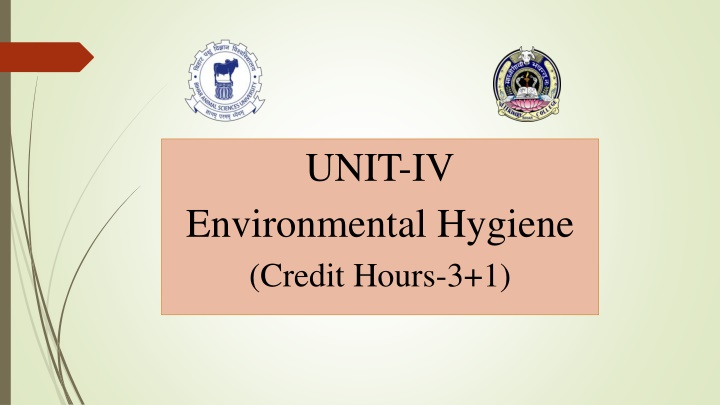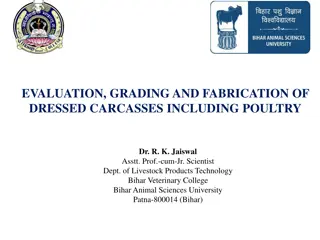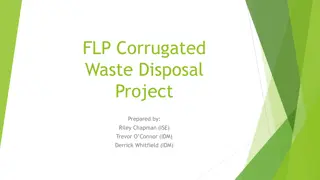Ensuring Hygienic Disposal of Carcasses and Fallen Animals
Disposing of carcasses and fallen animals is a crucial responsibility for veterinarians to maintain environmental hygiene and prevent health risks. Improper disposal can lead to the spread of diseases and attract pests. Various methods, such as burial, cremation, and incineration, are used to ensure safe and efficient disposal, with strict regulations in place in many countries.
Download Presentation

Please find below an Image/Link to download the presentation.
The content on the website is provided AS IS for your information and personal use only. It may not be sold, licensed, or shared on other websites without obtaining consent from the author.If you encounter any issues during the download, it is possible that the publisher has removed the file from their server.
You are allowed to download the files provided on this website for personal or commercial use, subject to the condition that they are used lawfully. All files are the property of their respective owners.
The content on the website is provided AS IS for your information and personal use only. It may not be sold, licensed, or shared on other websites without obtaining consent from the author.
E N D
Presentation Transcript
UNIT-IV Environmental Hygiene (Credit Hours-3+1)
Disposal of carcasses Hygienic disposal of dead/fallen animals: social as well as legal obligation Most important responsibilities of veterinarians: domain of environmental hygiene. Unsafe disposal of carcasses: serious threat to the health of animals & human communities. The tissues of dead animals: most conducive conditions for the breeding of flies & insects. Favors the growth of maggots within a day or two Many other welfare agencies along with environmental & health organization: safe & quick management/disposal of fallen/dead animals Some of the agencies relate to transport, tourism, natural resources, zoos & parks, & defense (air) services
Disposal of carcasses Regulations framed by Governmental/local authorities from time to time In western countries, the implementation of the regulations is rather strict For ex: In Scotland the service provided free of charge, In fact, the service paid for the carcasses of dead, injured/old animals A number of approaches: TO ensure efficient, environmentally safe & bio-secure disposal of carcasses & fallen animals Methods of disposal: 1. Traditional method: burial/burning, commonly used in developing countries 2. New technology: In developed countries, economic disposal of carcasses
Preparation of carcass for disposal 1. Cover the dead/ fallen body with A cloth or insect repellent Application of kerosene oil Prevent spread of disease through flies/insects 2. Covering of all natural orifices: Plugged with cotton plugs soaked with a suitable disinfectant Commonly used disinfectant: Carbolic acid or formalin 3. The Except for cases of anthrax, the so that it cannot be used by unscrupulous traders skin of the carcasses should be slashed with a sharp knife 4. Use of personnel protective measures (by wearing secure clothing, boots, gloves, goggles & face masks: to prevent the handlers
Preparation of carcass for disposal 5. Transport of dead animals: Desirable to use closed vehicle Animal should not be dragged under open condition Imp. part of sanitary practice 6. Site of disposal: Should be away from: Source of public water supply (pond, lake, well and river) From animal/human habitation Telephone or electric cables lines Fencing of site: To prevent access of wild animals & stray dogs to the site
Methods of disposal Following methods are used for the disposal of carcasses: 1. Cremation 2. Burial 3. Flamegun 4. Incineration 5. Rendering 6. Composting 7. Fermentation
Cremation Space required: Large animals: 1.7 - 2.5 m2space/head Small animals: 1.25 m2 space/head Various ways of cremation: Depends on the number of animals: Routine cremation: 1 or 2 Emergency/disaster conditions: large number of animals to be disposed
Cremation Methods of cremation of animals: Three methods 1. Cross-trench (pit) 2. Surface burning 3. Bostock pit method 1. Cross-trench (pit): Two trenches (2m x 40 cm with 40-45 cm depth) are dug at right angle The dug soil is heaped at the four right angles so created Wood, coal, straw, grass & tree branches are used to develop a pyre over the heaps of soil The carcass soaked in kerosene & paraffin is placed over the pyre & burnt
Cremation 2. Surface burning: Useful for the large number of animals to be cremated A trench dug: (90 cm x 30 cm with a depth of 40-50 cm) the length varies with the number of carcasses Carcasses are arranged in a way that head of a carcass is next to the hind quarter of the other Small animals (if any, can): used as fillers of spaces in between The carcasses are covered with kerosene, paraffin, wood & straw & burnt
Cremation 3. Bostock pit method: An oval pit (2m x 1.2 m with a depth of 1.2m) is dug A crossed trench (22 cm x 22 cm ) is then dug in its floor A ventilation trench (1.2 m x 45 cm ) with a depth of 30 cm deeper than the main pits dug at right angle to it The trench is then connected with a drain pipe with the pit The pit is filled with straw wood and coal for about 3 quarters of the pit The carcass is then put after soaking it with kerosene/paraffin and lighted
Burial Surface suitable for burial of a large carcass: 2.4-2.7 m deep For a horse: 2 -2.5 m2 For cattle: 1.25 -2 m2 For sheep/pig: 0.84 m2 The carcass is lowered on to a thick layer (about 5 cm thick may be sufficient under ordinary circumstances) of quicklime and then covered with sufficient (as required) amount of quicklime and soil. The soil cover over the carcass: about 1.8 - 2.0 m thick
Flamegun It is an economic & safe method The carcass is kept on the surface of the earth Burnt with the help of about 10 flameguns within few hours
Incineration The carcass is incinerated in a destructor/incinerator By using very high temperature: 1300oC The carcass can be dismembered into pieces before destruction
Rendering The materials/carcasses: from slaughterhouses & other sources Samples are collected in knackeries for processing The organs of dead & emergency slaughtered animals are sent to rendering plants Used to separate fat from the offal/tissues of dead animals Tallow: fat of sheep/cattle Lard: fat of pig Two process: Wet (autoclaving/steam) Dry (heat) methods
Rendering Remaining material used as meat meal & bone meal Meat meal: rich source of protein, vitamin B & minerals Bone meal: an important source of calcium & phosphorus Mixed with animal rations or pet foods Rendering of raw materials common in France, Germany & Italy It proves cheaper than burning the carcasses
Composting It is well known & environment friendly practice The procedure has been described by Casper Used for the disposal of manure & other animal house wastes The decomposition process includes Aerobic bacterial action Cold, warm & hot decomposition processes The process used for dead pigs in roofed non insulated silos The silos: horizontal or tower form The carcasses are lifted & dumped into the silos Covered with straw-horse manure mixture as bulking agents & carbon source Composting: achieved in 6-12 months The final product is used as fertilizer
Composting In the United States: successfully used to dispose of the carcasses Layering One part volume of carcass + 2 part volume of litter + 1 part volume of straw in a boxed area Layering is repeated In large animals litter can be replaced by manure Large carcasses: dismembered into pieces before being layered Birds/small carcasses are used as fillers within the layers Urea-10-15 pounds of per 1000 pounds of carcass Bacteria involve is: Bacillus sp. thermogenic at 60-68o/14 days
Fermentation The bacterial action is carried by Lactobacillus spp. under anaerobic conditions at 32-40oC The process is completed within 48 hr The fermented material can be used as livestock feed Rumen contents, blood & hydrolyzed feathers can be fermented (ensiled) in 6 weeks under rural conditions Offal and scrap are ensiled efficiently with the help of 3% formic acid The fermented product can be used as animal feed
Handling of stray and fallen animals Stray animals roam freely Create nuisance for the community in a number of ways including damage to crops They can be a serious hazard for vehicular traffic especially in congested urban areas These animals are more likely to be exposed to diseases & environmental toxicities When old & weak their movements become restricted The dung & urine excreted: become serious threats to environmental safety The filth created by such animals helps in the propagation of a variety of insects Fly breeding (maggots): real threat to community health & environment
The menace of stray animals can be minimized by collecting these animals in what are called cattle pounds which are managed by pound keepers The activity is regulated by the Cattle Trespass (Amendment) Act, 1921 In U.P., the act was enacted as the Cattle Traspass (Uttar Pradesh Amendment) Act, 1954 There are a number of private organizations that deal with the problem of old and decrepit animals In recent times, however, some goshalas have begun keeping even healthy cattle for breeding purpose and production The goshalas are supported by charitable organizations and occasional grants from the Government sources The activities of the goshalas are regulated by Goshala Acts (Bihar,1950 and U.P.,1964)
There has been a growing awareness about the welfare of animals The activities concerning animal welfare in India are regulated by Animal Welfare Board of India through the provisions of Prevention of Cruelty to Animals Act, 1960 The Board has its units spread all over the country and is engaged in providing protection to the animals from cruelty, disease and infirmity Stray animals dying in open areas cause enormous damage to environment They not only pollute the atmosphere with foul gases/odours but also invite vultures and wild animals to create nuisance These animals need to be collected immediately and disposed off in an economic and efficient manner as described in carcass disposal methods























